1000
Asia Pacific J Clin Nutr (1996) 5(4): 226-228
Asia Pacific J Clin Nutr (1996) 5(4): 226-228

Body composition of different ethnic
groups in South Africa
AJS Benadé DSc, A Oelofse MSc, M Faber MSc
National Research Programme for Nutritional
Intervention, Medical Research Council, Tygerberg, South Africa
Plenary lecture presented at an
APCNS Satellite Meeting of the Asian Congress of Nutrition on "Nutrition,
Body Composition and Ethnicity" in Tianjin, China on 5th October
1995.
South Africa is in a state of nutrition transition.
As with other societies this is reflected in the emergence of overfatness,
sometimes in conjunction with protein malnutrition. These phenomena
may be expressed differently in a multi-ethnic society like South
Africa with its major ethnic groups (Blacks, Whites, Coloureds and
Indians) having varied socio-economic status. National population-based
studies of coronary risk factors between 1979 and 1991 have been
accessed for anthropometric data as weight and height. Cut-off points
for overweight have been applied, to children to age 10 as weight-for-height
greater than two Z scores by NCHS reference standards, and to those
older than 15 and up to 64 years of age, BMI ³ 25 and < 30, and obese ³ 30 kg/m2. Data have been stratified by ethnicity, age,
gender and place of residence (urban or rural) Urban Black children
seem already to have a problem of overweight with a prevalence of
6-18%. For men, urban Whites have the highest prevalence of both
overweight (50% in the 45-54 age group) and obesity (20% in the
55-64 age group) in all age groups except the 55-64 age groups for
obesity, where Blacks have the higher prevalence (about 29%). Interestingly,
the prevalence of overweight in rural women overall (39-52%) exceeds
that for urban women (23-31%), although this is not the case for
obesity, (prevalence age 25 and beyond, rural 24-39% and urban,
25-60%) where, indeed, in the 45-54 and 55-64 age groups, the urban
prevalence exceeds the rural. This raises questions about the factors
which reduce or facilitate the transition from overweight to obesity.
Urban Black women seem at particular risk of this overweight-to-obesity
shift and are known to have a very energy-dense diet. The extent
to which overfatness contributes to other coronary risk factors
is worth further investigation, given this appears to be less for
Blacks than other ethnic groups.
Key Words: Body composition, ethnicity,
South Africa, overweight, obesity, children, adults
Introduction
Overweight and obesity are known to be related to
degenerative diseases such as 1000 atherosclerotic cardiovascular
disease, hypertension, diabetes mellitus, gall-bladder disease and
certain cancers. Anthropometric information from several South African
studies indicates a high prevalence of overweight and obesity in adult
males and females from various population groups residing in both
urban and rural areas. Although early evidence of overweight and obesity
is also evident in children younger than five years, undernutrition,
as manifested by the presence of underweight and retarded growth,
appears to be the major nutritional problem in this age group in South
Africa.
This article uses available anthropometric information
from various studies conducted in South Africa to obtain a comprehensive
picture of the prevalence of overnutrition in South Africa.
Methods
Prevalence data for overweight and obesity
in different population groups in South Africa were obtained from
four major studies conducted between 1979 and 1991. These studies
were primarily conducted to assess the coronary risk factor profiles
of four main population groups in South Africa, namely Blacks (BRISK
study)l, Whites (KORIS study)2, Coloureds (CRISIC
study)3, and Indians4. Information pertaining
to children under five years of age was obtained from unpublished
studies recently conducted by the Medical Research Council5.
Criteria for estimating overweight and obesity
in the various age groups were as follows:
- 0-10 years age group: Weight-for-height
exceeding 2 Z scores, according to the NCHS reference standards,
was considered to be overweight.
- Adolescents and adults: Body mass index
(BMI) was calculated as weight (kg)/height2 (m). Cut-off
points for obesity were BMI ³ 30 for all subjects and
for overweight at 30 >BMI ³ 25 for men and 30 >BMI
³ 24 for women.
Results are presented as the percentage of individuals
overweight or obese according to the above criteria and for the various
racial groups residing in rural or urban areas.
Results
Age group 0-10 years: The limited information
available for this group suggests that between 2 and 10% of urban
Coloured children and between 6 and 18% of urban Black children are
either overweight or obese (Figures 1 and 2).
Figure 1. Percentage urban males
either overweight or obese. (Z > 2 or BMI>24).
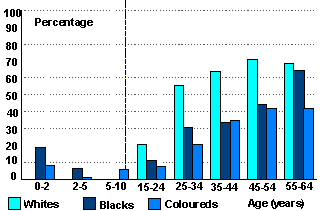
Whites: no children; >15 years:
KORIS;
Blacks: children: Kayamandi / >15 years: BRISK;
Coloureds: children: Scottsville/Cloetesville / >15 years: CRISIC
Figure 2. Percentage urban females
either overweight or obese. (Z > 2 or BMI>24)
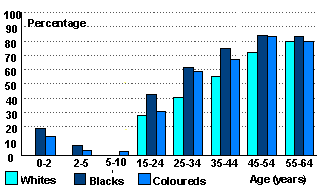
Whites: no children; >15 years:
KORIS
Blacks: children: Kayamandi / >15 years: BRISK
Coloureds: children: Scottsville/Cloetesville / >15 years: CRISIC
Overweight in the 15-64 year age group
(Figures 3 and 4): The prevalence of overweight shows a clear tendency
to increase with age in all ethnic groups, in both males and females.
The prevalence of overweig 1000 ht was highest in White males for
all age groups, while the prevalence of overweight among Indian women
exceeded that for the other ethnic groups in the 35-64 year age group.
Figure 3. Percentage urban overweight
males. (BMI between 25 and 30)
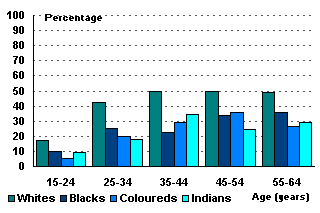
Whites: KORIS; Blacks: BRISK; Coloureds: CRISIC
Figure 4. Percentage urban overweight
females. (BMI between 24 and 30)
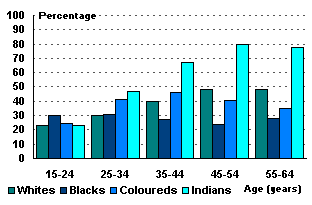
Whites: KORIS; Blacks: BRISK; Coloureds: CRISIC
Figure 5 shows the prevalence of overweightness in
urban and rural females. The prevalence of overweightness among rural
women is almost double that observed in urban women.
Figure 5. Percentage urban versus
rural overweight females (BMI between 24 and 30).
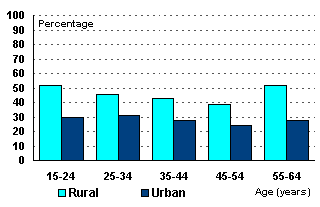
Rural: Ndunakazi; Urban: BRISK
Prevalence of obesity: Obesity tends
to increase with age in both males and females (Figures 6 and 7).
The prevalence of obesity in women was about two to three times higher
than that found in men. More Black and Coloured women were found to
be obese than either White or Indian women.
Figure 6. Percentage urban obese
males (BMI > 30)
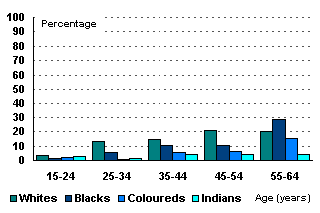
Whites: KORIS; Blacks: BRISK; Coloureds: CRISIC
Figure 7. Percentage urban obese
females (BMI > 30)
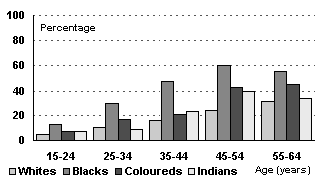
Whites: KORIS; Blacks: BRISK; Coloureds: CRISIC
When prevalence rates for obesity among rural and
urban Black women were compared, far more urban than rural women were
found to be obese, especially after the age of 45 years (Figure 8).
Figure 8. Percentage urban versus
rural obese females (BMI > 30)
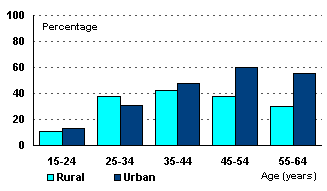
Rural: Ndunakazi; Urban: BRISK
Discussion
A feature of the results reported by the different
South African studies on different ethnic groups is the increase in
the prevalence of both overweight and obesity with age in both males
and females. In males and females of all ethnic groups, overweight
was found to increase about two-fold after the age of 25. The prevalence
of overweight was found to be very similar in males and females after
the age of 25, apart from Blacks. It is interesting to note that although
more White males were overweight than any of the other groups, Indian
women had a prevalence rate of overweight almost double that observed
in White women2,4 of 25 years and older.
Obesity was found to be rare in males of all ethnic
groups. More women than men tended to become obese as they grew older.
The highest prevalence of obesity was found among the Black and Coloured
groups, especially after the age of 25 years.
An interesting feature of our data is the higher prevalence
of obesity among urban Black women after middle age, as compared to
rural Black women of the same age range. Although the reason for this
is not known, changes in dietary and exercise patterns associated
with urbanisation are likely explanations. Urbanised Blacks are known
to consume a much more energy-dense diet6 than rural populations7.
If more energ ce0 y-dense food is consumed by the already overweight
progress to obesity is more likely.
Although some relationship appears to exist between
overweight/obesity and certain risk factors for cardiovascular disease,
such as elevated blood cholesterol and high blood pressure in White
males and females, Black males and females have lower prevalence rates
for all three major risk factors compared with Whites, Indians and
Coloureds1. The high prevalence of overweight and obesity
in Blacks therefore does not appear to be associated with an increase
in the prevalence of risk factors for coronary heart disease as observed
in the other population groups. This issue should be investigated
further.
Body composition of different ethnic
groups in South Africa
AJS Benadé, A Oelofse,
M Faber
Asia Pacific Journal of Clinical
Nutrition (1996) Volume 5, Number 4: 226-228
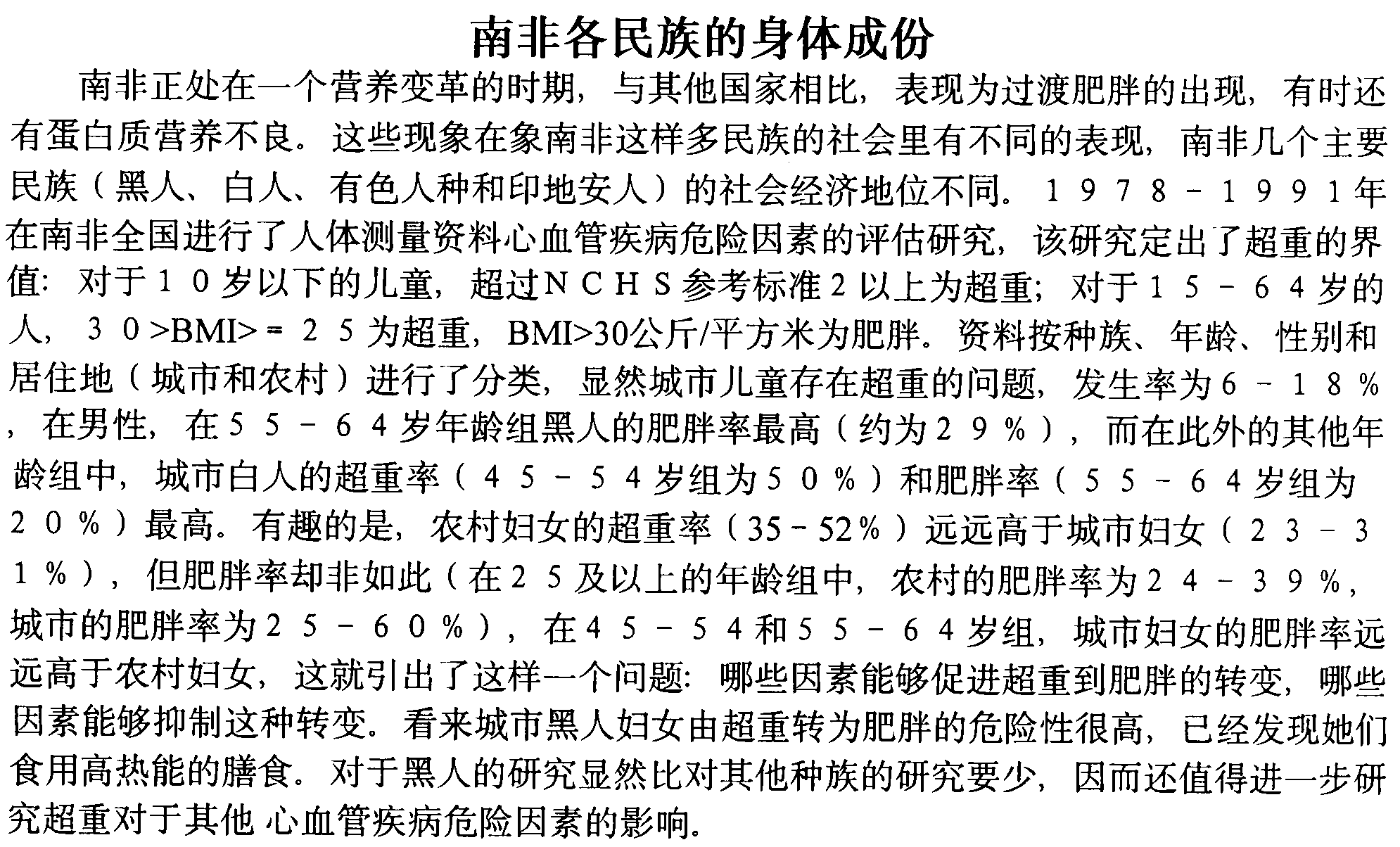
References
- Steyn K, Jooste PL, Bourne L, et al. Risk factors
for coronary heart disease in the Black population of the Cape Peninsula.
S Afr Med J 1991; 79: 480485.
- Jooste PL, Steenkamp HJ, Benadé AJS, Rossouw JE.
Prevalence of overweight and obesity and its relation to coronary
heart disease m the CORIS study. S Afr Med J 1988; 74: 101104.
- Steyn K, Fourie J, Rossouw JE, et al. Anthropometric
profile of the Coloured population of the Cape Peninsula. S Afr
Med J 1990; 78: 68-72.
- Seedat YK, Mayet FGH, Khan S, et al. Risk factors
for coronary heart disease in Indians in Durban. S Afr Med J 1990;
78: 447454.
- Benadé AJS, Oelofse A, Faber M. Unpublished data.
- Bourne LT, Langenhoven ML, Steyn K, et al. Nutrient
intake in the urban African population of the Cape Peninsula, South
Africa. The BRISK study. Central Afr J Med 1993; 12: 238-247.
- Langenhoven ML, Wolmarans P, Groenewald G, et al.
Nutrient intake and food meal patterns in South African population
groups. Front Gastrointest Res 1988; 14: 4148.

Copyright © 1996 [Asia Pacific Journal of Clinical
Nutrition]. All rights reserved.
Revised:
January 19, 1999
.
 to the top
to the top
0